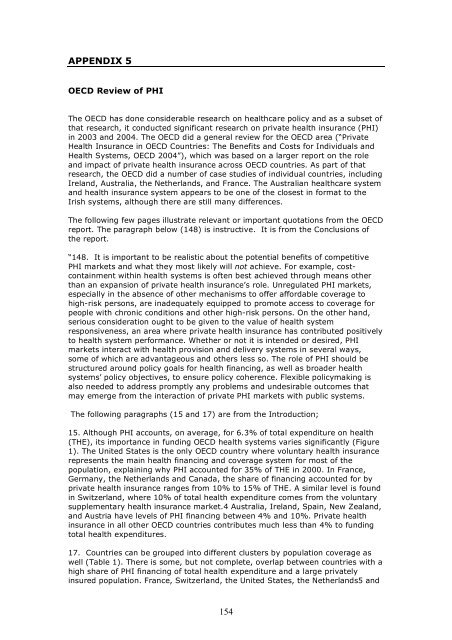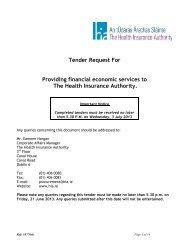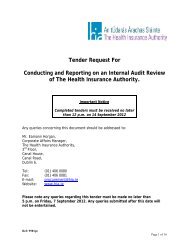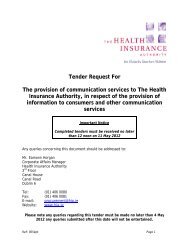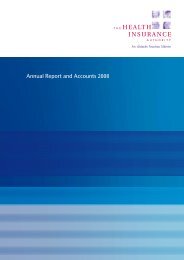Competition in the Irish Private Health Insurance Market
Competition in the Irish Private Health Insurance Market
Competition in the Irish Private Health Insurance Market
You also want an ePaper? Increase the reach of your titles
YUMPU automatically turns print PDFs into web optimized ePapers that Google loves.
APPENDIX 5<br />
OECD Review of PHI<br />
The OECD has done considerable research on healthcare policy and as a subset of<br />
that research, it conducted significant research on private health <strong>in</strong>surance (PHI)<br />
<strong>in</strong> 2003 and 2004. The OECD did a general review for <strong>the</strong> OECD area (“<strong>Private</strong><br />
<strong>Health</strong> <strong>Insurance</strong> <strong>in</strong> OECD Countries: The Benefits and Costs for Individuals and<br />
<strong>Health</strong> Systems, OECD 2004”), which was based on a larger report on <strong>the</strong> role<br />
and impact of private health <strong>in</strong>surance across OECD countries. As part of that<br />
research, <strong>the</strong> OECD did a number of case studies of <strong>in</strong>dividual countries, <strong>in</strong>clud<strong>in</strong>g<br />
Ireland, Australia, <strong>the</strong> Ne<strong>the</strong>rlands, and France. The Australian healthcare system<br />
and health <strong>in</strong>surance system appears to be one of <strong>the</strong> closest <strong>in</strong> format to <strong>the</strong><br />
<strong>Irish</strong> systems, although <strong>the</strong>re are still many differences.<br />
The follow<strong>in</strong>g few pages illustrate relevant or important quotations from <strong>the</strong> OECD<br />
report. The paragraph below (148) is <strong>in</strong>structive. It is from <strong>the</strong> Conclusions of<br />
<strong>the</strong> report.<br />
“148. It is important to be realistic about <strong>the</strong> potential benefits of competitive<br />
PHI markets and what <strong>the</strong>y most likely will not achieve. For example, costconta<strong>in</strong>ment<br />
with<strong>in</strong> health systems is often best achieved through means o<strong>the</strong>r<br />
than an expansion of private health <strong>in</strong>surance’s role. Unregulated PHI markets,<br />
especially <strong>in</strong> <strong>the</strong> absence of o<strong>the</strong>r mechanisms to offer affordable coverage to<br />
high-risk persons, are <strong>in</strong>adequately equipped to promote access to coverage for<br />
people with chronic conditions and o<strong>the</strong>r high-risk persons. On <strong>the</strong> o<strong>the</strong>r hand,<br />
serious consideration ought to be given to <strong>the</strong> value of health system<br />
responsiveness, an area where private health <strong>in</strong>surance has contributed positively<br />
to health system performance. Whe<strong>the</strong>r or not it is <strong>in</strong>tended or desired, PHI<br />
markets <strong>in</strong>teract with health provision and delivery systems <strong>in</strong> several ways,<br />
some of which are advantageous and o<strong>the</strong>rs less so. The role of PHI should be<br />
structured around policy goals for health f<strong>in</strong>anc<strong>in</strong>g, as well as broader health<br />
systems’ policy objectives, to ensure policy coherence. Flexible policymak<strong>in</strong>g is<br />
also needed to address promptly any problems and undesirable outcomes that<br />
may emerge from <strong>the</strong> <strong>in</strong>teraction of private PHI markets with public systems.<br />
The follow<strong>in</strong>g paragraphs (15 and 17) are from <strong>the</strong> Introduction;<br />
15. Although PHI accounts, on average, for 6.3% of total expenditure on health<br />
(THE), its importance <strong>in</strong> fund<strong>in</strong>g OECD health systems varies significantly (Figure<br />
1). The United States is <strong>the</strong> only OECD country where voluntary health <strong>in</strong>surance<br />
represents <strong>the</strong> ma<strong>in</strong> health f<strong>in</strong>anc<strong>in</strong>g and coverage system for most of <strong>the</strong><br />
population, expla<strong>in</strong><strong>in</strong>g why PHI accounted for 35% of THE <strong>in</strong> 2000. In France,<br />
Germany, <strong>the</strong> Ne<strong>the</strong>rlands and Canada, <strong>the</strong> share of f<strong>in</strong>anc<strong>in</strong>g accounted for by<br />
private health <strong>in</strong>surance ranges from 10% to 15% of THE. A similar level is found<br />
<strong>in</strong> Switzerland, where 10% of total health expenditure comes from <strong>the</strong> voluntary<br />
supplementary health <strong>in</strong>surance market.4 Australia, Ireland, Spa<strong>in</strong>, New Zealand,<br />
and Austria have levels of PHI f<strong>in</strong>anc<strong>in</strong>g between 4% and 10%. <strong>Private</strong> health<br />
<strong>in</strong>surance <strong>in</strong> all o<strong>the</strong>r OECD countries contributes much less than 4% to fund<strong>in</strong>g<br />
total health expenditures.<br />
17. Countries can be grouped <strong>in</strong>to different clusters by population coverage as<br />
well (Table 1). There is some, but not complete, overlap between countries with a<br />
high share of PHI f<strong>in</strong>anc<strong>in</strong>g of total health expenditure and a large privately<br />
<strong>in</strong>sured population. France, Switzerland, <strong>the</strong> United States, <strong>the</strong> Ne<strong>the</strong>rlands5 and<br />
154


